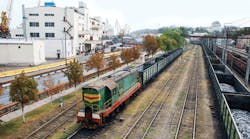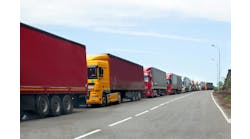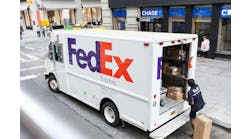The sheer volume of goods flowing through U.S. ports can overwhelm their capacity to process those goods. Increasingly, containers shipped to the U.S. are transferred mostly by rail from the port of entry to an inland port. New inland ports are being designed and located to accommodate today’s just-in-time demands.
Transport development began shifting inland during the 1990s due to issues with congestion, energy consumption and empty moves (empty containers moving to/from the port). Other factors influenced the move to develop inland ports, including:
- Limited land available for expansion around ports;
- Congestion in and around ports;
- Coastal ports strained to their capacity limits;
- Dramatic increase in cost of land and lease rates due to lack of real estate around major seaports.
Shipping across oceans is on the rise and companies are looking for ways to both increase ship container capacity and reduce cost. As more ships arrive with more containers, increased shipments and container volumes create problems as goods seeking to reach their final destinations tax coastal roadways and rail systems, and ultimately create demand constraints for well-connected warehousing.
As fleets expand in response to developing world trade, port capacity is strained. Though many seaports plan major infrastructure improvements, congestion will still present challenges to timely, cost-effective distribution of inbound containerized shipments to noncoastal retailers, manufacturers and ultimately consumers.
As inbound containers flood into a seaport, they must be moved quickly from the port. Otherwise, they create a bottleneck that bogs down the entire distribution cycle as containers wait longer to be removed from ships, to be delivered to warehouses and to get back out and onto trucks and trains for final shipment.
Though the concept of inland ports is not new, these sites are becoming increasingly critical to the global supply chain and will affect logistics decisions ranging from shipping routes to warehouse locations.
An inland port is a specialized facility that originated with the intermodal container in international transport. Containers arrive by ocean carriers to a seaport where they are received, processed through customs, inspected, sorted and then transferred to a motor carrier or train for delivery to the end customer. Transferring some of these functions to an inland port, which is located away from the port and coast, can speed up processing and distribution.
Inland ports are located throughout North America, and others are under construction or being proposed. Many inland ports are actually former military bases and are serviced by miles of rail track that runs into and out of inland ports. High performance inland ports are bigger and offer more facilities, such as warehouses and distribution centers, which include equipment for the handling of materials: conveyors, picking, packing and storing equipment.
Technology and Inland Ports
Inland ports need technology solutions just like seaports, ocean carriers, motor carriers and other transportation units do. Solutions exist that inland ports can use to find motor carriers and rail carriers to transport products to end customers.
Using a solution for scheduling appointments at the ports eliminates waiting times. Slot booking applications allow shippers and carriers to schedule appointments and book time slots at loading and unloading facilities, which streamlines their loading workflows and reduces delays and wait times for carriers, resulting in lower assessorial charges and fewer scheduling resources. Anything inland ports can do to speed up the loading and unloading process, decrease dwell time, reduce errors and ensure they have the right personnel, equipment and space available for carriers, the happier carriers will be.
Slot booking provides visibility for shippers and carriers on availability of dock, labor and warehouse configurations/schedules and detailed load information. It validates that appointments follow the shipper’s business rules and site setup. In addition, the solution provides pro-active alerting to both shippers and carriers when new appointments, modifications of appointments, or cancellations are entered in the system.
By ensuring all supply chain partners are involved in the process and have visibility into requested, scheduled and rescheduled dock appointments, slot booking optimizes road carrier collaboration within the logistics operations while improving productivity.
Solutions that provide visibility into transportation moves allow shippers to process transport instructions, follow the execution of these instructions and measure the performance of ocean and inland service providers. Having a comprehensive, holistic view into the entire logistics network gives shippers and carriers at inland ports immediate access to information so they can find capacity, container availability and comparative shipping rates.
Utilizing a collaborative network of trading partners helps manage communications and gain visibility among supply chain stakeholders while eliminating errors and minimizing disruptions. Capturing transaction data, across all trading partners, and translating it into actionable information allows trading partners on the network to collectively sense and properly respond to supply and demand changes in the market.
Benefits of Using Inland Ports
- Reduce inefficiencies by the combination of transportation modes;
- Location advantages—located near large metropolitan areas, which supply workers and a market for the companies operating in the inland port;
- Time-sensitive goods spend less time waiting at seaports, therefore improving throughput and fulfillment rates;
- Helps lower energy consumption with less waiting and idling time;
- Speeds distribution to end-customer;
- Slot booking applications exist for scheduling of labor for loading and unloading, while carriers have minimal wait times;
- Using technology, shippers gain a comprehensive view of trading partners’ availability, rates and performance data;
- Provide space for necessary warehousing and distribution facilities.
Another advantage of inland ports is that they often house large volumes of empty containers, which creates a perfect opportunity for exporters to load them and return to seaports for shipping. Motor carriers pick up a full import container at the port for delivery to the inland port where cargo is unloaded and the empty container is transported directly to the export shipper. The container is filled with export cargo and the motor carrier returns the laden container to the port. One entire empty leg is removed, which dramatically reduces empty miles and improves efficiencies in asset utilization.
Big box retailers and manufacturers have facilitated the growth of inland ports because they need large-scale distribution centers located near metropolitan areas in order to inventory products and ship them to consumers. Inland ports offer space for expansion, tax incentives, direct connections to interstate roadways, intermodal rail facilities and air cargo operations. Many of these companies have been able to save money by consolidating multiple distribution centers into a smaller number of hubs situated at inland ports with adequate logistics capacity.
The Future of Inland Ports
With the coming of mega ships, many seaports are deepening their channels to accommodate them. The expansion of the Panama Canal will be an immediate game changer as it will allow these mega ships to pass through carrying almost three times as many containers. Many East Coast and West Coast ports have plans to accept these larger ships. Regardless, there will definitely be a dramatic increase in container volume, triggering the need to develop more inland ports to handle the increase in traffic.
Chris Cameron is a logistics solutions architect for Elemica (www.elemica.com), a supply chain operating network provider.



